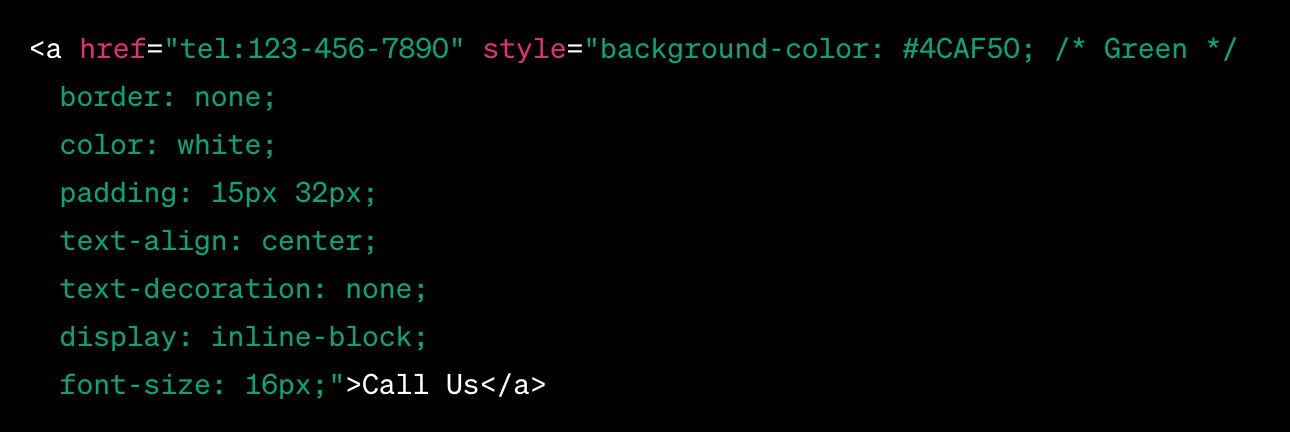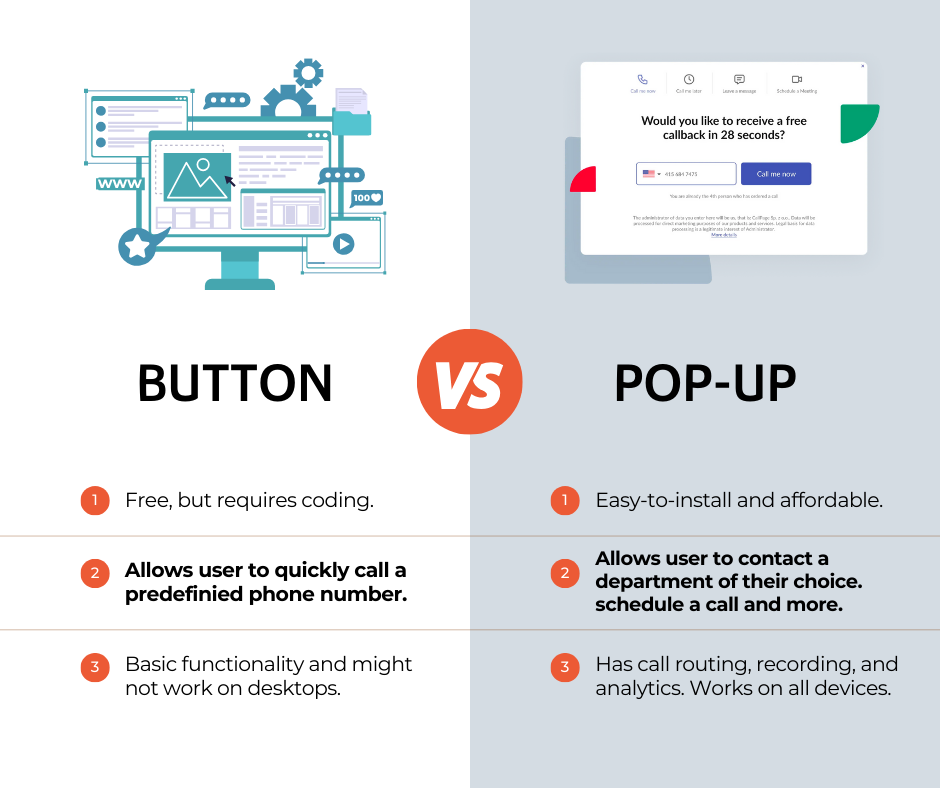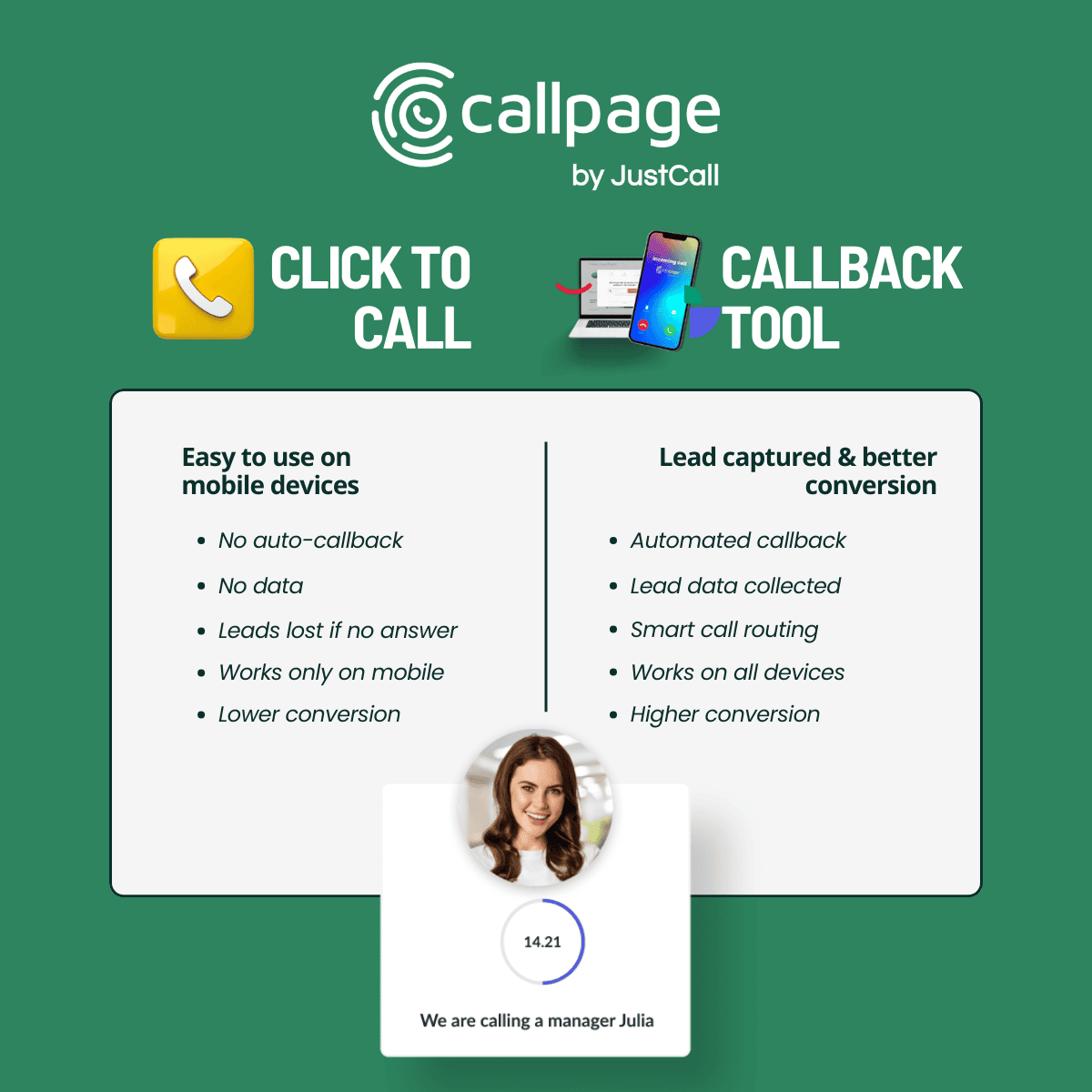How to Add a Click-To-Call HTML Button to Your Website (+ Useful Alternative)
In this article, we’ll show you how to make your phone number clickable on your website to get more customer clicks and calls. Learn the steps to easily set up a click-to-call button using HTML, and read on to discover a great alternative!
The easier it is for potential customers to reach out, the more likely they are to do so. That’s where a click-to-call button comes in handy. This user-friendly feature can improve the way your clients engage with your website. Let’s dive into how to implement this practical tool on your site.
What Is a Click-To-Call Button?
Click-to-call buttons function precisely as their name suggests. They enable website visitors to access your phone number through a click-to-call link. When a user clicks the button, it dials your number automatically. Isn’t that convenient?
Best of all, it works perfectly on both mobile devices and desktop platforms. Keep in mind Mac fans need FaceTime, and Windows folks need the Your Phone app. But apart from that, these click-to-call buttons make reaching your business effortless. Say goodbye to waiting for callbacks after filling out lengthy forms. Now, your customers can connect with you instantly with just one click. It’s all about efficiency, and you’ll be surprised at the increase in responsiveness from your audience.
Why You Should Make Your Phone Number Clickable
Imagine this scenario: potential clients are exploring your website, captivated by your products or services. Instead of scribbling down your phone number or copying it to their dial pad, they can simply click a button on the screen. Voila! Your phone rings, and you’re ready to secure that business deal.
Making your phone number clickable can also help increase conversions by making it easier for customers to contact you.
The benefits of a click-to-call button
A click-to-call button is like giving customers a shortcut to your doorstep. It lets them contact you instantly, bypassing the need to enter your phone number manually. And that usually means you’ll get more inbound calls.
But that’s not all. A click-to-call button helps reduce the chances of dialing errors. With the number preloaded, the risk of typing in the wrong number decreases.
And the cherry on top? With click-to-call functionality, you get to play detective, tracking the source of the calls. You will be ale to check how many people has clicked the phone number on your pages. Integrating click-to-call buttons can enhance your marketing efforts and support digital marketing strategies by providing valuable call data, making your campaigns more effective and improving overall ROI. On the other hand, if users dial the phone number manually, you’ll never know where they came from. Now, isn’t that something worth considering?
To sum up:
- Instant connection – No copy-pasting, no typing, just one click.
- Fewer errors – Since the number is preloaded, users won’t misdial.
- Higher conversion rates – Phone calls convert up to 10x better than online forms.
- More inbound calls – Adding a simple button can boost calls.
- Trackability – Unlike manually dialed calls, click-to-call links can be tracked in analytics.
For more benefits explore click to call software options.
How to Set Up a Click-To-Call HTML Button
Adding a click-to-call button to your website is relatively straightforward. Here’s a simple step-by-step guide using the standard link tag in HTML. By adding just a single line of code, you can create a clickable phone number that users can tap to call directly from your site. This is known as a click to call link.
The <a> tag with the tel: protocol creates an html link that enables click to call functionality, making it easy for users on smartphones and desktops to initiate a call.
Choose a location
Start by figuring out the best spot for your click-to-call button. You want to ensure it’s both visible and accessible for your website visitors. It could be placed at the top of your website, perhaps in the header or at the bottom in the footer, ensuring it’s always within reach.
In website builders like WordPress, you can use a block editor or an html block to add a button widget for your click-to-call feature. This allows you to easily insert and customize the button’s appearance and placement.
An alternative idea is to make your button a floating one. A floating button stays visible on the screen and moves along as visitors scroll up or down your page. This means no matter where your visitors are on your website, the call button is always available.
Consider your website’s layout, design, and user journey when deciding on the button’s placement. You might want to conduct some A/B testing to find out which location leads to the highest engagement.
Or read the articles - where should a lead generation website feature its phone-number.
Create the click-to-call button
After you’ve picked the right spot, it’s time to make your button. Don’t worry, it’s simple! You’ll build this interactive button using HTML code, one of the foundational languages of the internet.
HTML, short for HyperText Markup Language, is used to structure content on web pages. This language is supported by all website builders and content management systems (CMS), including popular ones like WordPress, Wix, Squarespace, and Shopify. So no matter which platform you’re using to host and build your website, you should have the ability to insert a snippet of HTML code seamlessly.
To add the code, you may need to click edit on your page or post, then access the html editor or select a custom html section in your website builder. In most cases, you can simply paste the code snippet into the html editor or custom html block. Some website builders may also prompt you to enter your phone number in a text field or select phone number options for the button.
Here’s an example of what the code can look like:
< a href=”tel:123-456-7890”>Call Us< /a>
Just remember to swap out “123-456-7890” with your actual phone number.
Style your button
Okay, so you have a clickable link. It’s time to make it look like a button. And make it look good.
You’ll be using CSS styles for this. CSS, short for Cascading Style Sheets, is used to style and layout web pages — for example, to change fonts, colors, and spacing. To apply inline styles, you add the “style” attribute to your HTML code, followed by the CSS properties and values that you want to apply.
Let’s apply this to our button:


In the example above, the style attribute adds several CSS properties to our link:
“background-color: #4CAF50;” changes the background color of the button to a shade of green. You can adjust the button color to match your branding.
“color: white;” changes the text color to white.
“padding: 14px 20px;” adds some space around the text to make the button bigger and easier to click.
“text-align: center;” centers the text within the button.
“text-decoration: none;” removes the underline that is typically seen on text links.
“display: inline-block;” allows us to set a width and height for the button.
Remember to customize your button to match your site’s design. You can change the button color, padding, font, and more simply by swapping out these CSS values. For more advanced styling, you can use custom CSS to further enhance the appearance and branding of your button. Also, make sure your button design is mobile friendly so it looks great and works well on smartphones. Just make sure your button still stands out and is easy to click.
If you’d like to copy the HTML code we’ve just shown you, here it is:
< a href=”tel:123-456-7890” style=”background-color: #4CAF50; border: none; color: white; padding: 15px 32px; text-align: center; text-decoration: none; display: inline-block; font-size: 16px;”>Call Us< /a>
Advanced Control with JavaScript
If you want more flexibility (e.g., using a <button> element, or tracking clicks before the call), you can use JavaScript:
<button id="call-button">Contact Us</button>
<script>
const callButton = document.getElementById('call-button');
callButton.addEventListener('click', () => {
const phoneNumber = '+48123456789';
window.location.href = `tel:${phoneNumber}`;
});
</script>
Test your clickable phone number
Lastly, don’t forget to test your button. Try it out on different devices and browsers to ensure it’s working correctly. Make sure to test the click-to-call button for both desktop users and mobile users, verifying that it functions properly and provides a seamless experience across all platforms.
Click-To-Call on Different Platforms
Adding a click to call button to your website is easy, no matter which platform you use. On WordPress, you can quickly add a click to call button by pasting a simple HTML code snippet into your page or post, or by using a dedicated plugin for even more customization. Wix makes it just as straightforward—simply click the “+” sign, choose “Button,” and select from “Text & Icon Buttons” to add a clickable phone number to your site. Squarespace users can click “+ Add Block,” then select “Button” to create a call button that fits seamlessly into their design.
Each platform offers its own options for customizing the look and feel of your click to call buttons, so you can match your branding and make the button stand out to website visitors. Whether you’re pasting code, using a plugin, or adding a button block, you’ll be able to create a clickable phone number that makes it easy for users to get in touch with just a tap. By understanding the specific steps for your website builder, you can ensure your click to call feature is both effective and user-friendly.
- WordPress: Add a Custom HTML block in Gutenberg, or use Elementor’s Button widget and set the URL. Or try CallPage plugin.
- Wix / Squarespace: Insert the <a> link in an HTML embed block.
- Shopify / BigCommerce: Paste the link inside a custom HTML block or edit theme.liquid
Responsive Design for Click-To-Call Buttons
A responsive design is essential for making sure your click to call button works perfectly on every device. Whether your visitors are browsing on mobile devices, tablets, or desktop computers, your call button should always be easy to find and use. To achieve this, use CSS media queries to adjust the button’s size, color, and placement based on the screen size. For example, you might use a larger font size and a wider button on desktop screens, while keeping the button compact and thumb-friendly on mobile devices.
Make sure your click to call buttons remain visible and accessible as users scroll through your website. Test your design on different devices to confirm that the button is always easy to tap or click, no matter the screen size. By prioritizing responsive design, businesses can ensure that every visitor has a smooth experience and can access the click to call feature whenever they need it.
User Engagement: Maximizing Click-To-Call Effectiveness
To truly maximize the impact of your click to call buttons, focus on creating an engaging experience that encourages users to take action. Use clear, compelling calls-to-action that highlight the benefits of calling, such as “Get a Free Quote” or “Talk to a Specialist Now.” Make sure your click to call button is prominently displayed and easy to access, reducing the number of steps a visitor needs to take to reach you.
Leverage analytics tools to track how visitors interact with your click to call buttons. By monitoring user behavior and button performance, you can fine tune your strategy—adjusting placement, design, or messaging to boost engagement and drive more calls. The goal is to create a seamless, user-friendly experience that increases customer satisfaction and leads to more conversions. When businesses prioritize user engagement, they not only make it easier for customers to connect, but also set the stage for more sales and long-term loyalty.
Click-To-Call Widget — A Practical Alternative
You know what's even better than a click-to-call button? Click to call widget! It's another excellent tool you can use to streamline communication with your site visitors. Similar to a click-to-call button, a widget also initiates a phone call once clicked.

READ ALSO: What Is Click-to-Call Software? The Ultimate Guide
Why Choose a Widget over a Button?
The choice between a widget and a button depends on your specific needs and goals. A button is simple and gets the job done with minimal fuss. However, a widget offers more functionality. Here's a list of the most important benefits.
- Customizability: Widgets are typically more customizable than buttons. You can modify their appearance to match your website design, making the user experience more seamless.
- Multi-functionality: Unlike a button that serves only one function — initiating a call — widgets have more than just the click-to-call functionality. For instance, they can provide an option to call now, schedule a call for later, leave a message, or even schedule a meeting (like in the case of CallPage).
- Advanced Features: Widgets can integrate more advanced features like real-time availability status, call routing based on the department or the purpose of the call, and auto-responses.
- Analytics and Insights: Widgets can integrate with analytics software to provide useful data, such as the number of calls initiated, call durations, peak call times, and more. This can help businesses make informed decisions.
- Lead Generation and Management: Widgets can collect and manage customer information, such as phone numbers, names, and the reason for the call. This aids in lead generation and management, providing valuable insights for future marketing campaigns.
- CRM Integration: Some widgets can integrate with Customer Relationship Management (CRM) systems, helping businesses to keep track of customer interactions and improving customer service.
How to setup a click-to-call widget (pop-up)?
First, look up the most popular click-to-call widget providers. Research and choose the one that suits your business needs the most.
The setup process itself is simple. Most widget providers will guide you through the whole thing. You'll typically need to create an account and then follow their instructions to customize your widget's appearance, functions, and phone number.
Then you have to install the widget on your website. You'll receive a piece of code, which you'll need to insert into your website's HTML code, often in the header or footer. Some widget providers offer plugins for website builders like WordPress, making installation even easier.
Like the click-to-call button, always remember to test your widget after setting it up. Confirm that it's working correctly across different devices and browsers.

Best Practices
To get the most out of your click-to-call widget, it’s important to follow a few best practices that can make a real difference in customer satisfaction and sales. First, make sure your click to call buttons are placed where your visitors are most likely to look for them—think landing pages, contact forms, and any page where a customer might want to reach out. The call button should be easy to spot and accessible, especially on mobile devices where users expect quick, one-tap access to your business.
When creating your click to call button, use a clear and action-oriented call-to-action, like “Call Now” or “Speak to an Expert.” This encourages users to take the next step. Double-check that your phone number is correctly formatted in the HTML code, including the country code and without any unnecessary dashes or spaces. This ensures that the click to call feature works smoothly for all users, no matter where they’re located.
Finally, test your click to call buttons regularly to make sure they’re working as intended. By following these best practices, businesses can create a seamless experience that increases conversions, drives more sales, and keeps customers happy.
Need Click-To-Call? Try Out CallPage!
CallPage is a leading provider of click-to-call solutions with a wide range of features that make connecting with customers even more seamless. With customizable widgets that offer advanced functions like scheduling calls and meetings, virtual PBX, and useful analytics, CallPage could be the perfect fit for your business needs.
Is it really effective, though? Well, let's look at some CallPage case studies and statistics. FaktorOne (previously IdeaMoney), one of our customers, has been generating around 800 phone calls with our platform every month! They also boast a 96% call success rate. Pretty good if you ask us.
However, if you're not convinced yet, we also offer a free trial period. Go ahead and explore our platform's features and see if it's a good fit for your business. Test the difference that a click-to-call phone icon and widget can make for yourself.
You'll find it easy to set up, and we'll support you along the way.
Let's Sum Up
Quick and effortless communication is key, adding a click-to-call button or widget to your website is a simple yet effective way to boost phone call conversion rates. Don't let potential customers slip away due to inconvenient contact methods.
Try CallPage click-to-call functionality today and see the difference it can make for your business!
Check out other posts
Start generating leads today!
Get a 14-day free trial now,
set up the widget on your site, and see how many more leads you can capture with CallPage
- No credit card required
- 10 minutes set up
- 14 days fully-features free trial